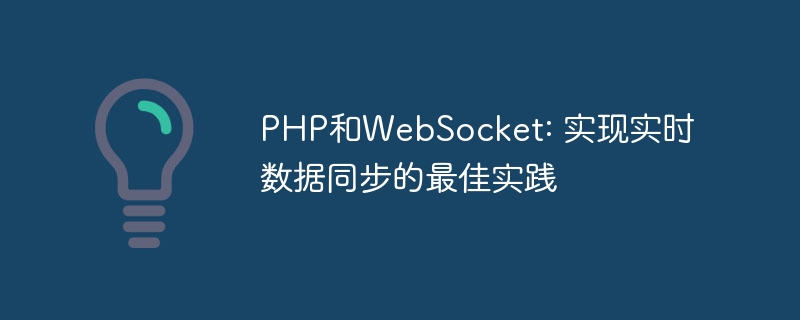

PHP and WebSocket: Best Practices for Real-Time Data Synchronization
Introduction:
In the development of modern Internet applications, real-time data synchronization has become a important needs. The traditional HTTP request-response model cannot meet the requirements of real-time data, and WebSocket, as a full-duplex communication protocol, can realize real-time data transmission between the client and the server. This article will introduce how to use PHP and WebSocket to achieve real-time data synchronization and give specific code examples.
1. Introduction to WebSocket
WebSocket is a full-duplex communication protocol based on the TCP protocol, which allows the server to actively push messages to the client, and the client can also send messages to the server. Compared with the traditional HTTP request-response model, WebSocket has the following advantages:
2. PHP implements WebSocket server
To implement WebSocket server in PHP, we can use the ratchet library, which is a powerful WebSocket development framework based on the ReactPHP framework. The following is a sample code for a simple PHP WebSocket server:
<?php
require 'vendor/autoload.php';
use RatchetMessageComponentInterface;
use RatchetConnectionInterface;
use RatchetServerIoServer;
use RatchetHttpHttpServer;
use RatchetWebSocketWsServer;
class MyWebSocketServer implements MessageComponentInterface
{
protected $clients;
public function __construct()
{
$this->clients = new SplObjectStorage;
}
public function onOpen(ConnectionInterface $conn)
{
// 当有新的客户端连接时触发
$this->clients->attach($conn);
echo "New connection! ({$conn->resourceId})
";
}
public function onMessage(ConnectionInterface $from, $msg)
{
// 当收到消息时触发
foreach ($this->clients as $client) {
$client->send($msg); // 将消息发送给所有客户端
}
}
public function onClose(ConnectionInterface $conn)
{
// 当客户端断开连接时触发
$this->clients->detach($conn);
echo "Connection {$conn->resourceId} has disconnected
";
}
public function onError(ConnectionInterface $conn, Exception $e)
{
// 当发生错误时触发
echo "An error has occurred: {$e->getMessage()}
";
$conn->close();
}
}
$server = IoServer::factory(
new HttpServer(
new WsServer(
new MyWebSocketServer()
)
),
8080
);
$server->run();The above code uses the ratchet library to create a WebSocket server and implements the callback function of the MessageComponentInterface interface. Among them, onOpen(), onMessage(), onClose(), and onError() are the four important event callback functions of the WebSocket server.
3. Client implementation
On the client side, we can use JavaScript's WebSocket API to communicate with the server. The following is a simple JavaScript code example:
var serverUrl = 'ws://localhost:8080'; // 服务器地址
var socket = new WebSocket(serverUrl);
socket.onopen = function(event) {
console.log("Connected to server");
};
socket.onmessage = function(event) {
var message = event.data;
console.log("Received message: " + message);
// 进行相应的处理逻辑
};
socket.onclose = function(event) {
console.log("Disconnected from server");
};
socket.onerror = function(event) {
console.log("An error has occurred");
};In the above code, we create a WebSocket instance that establishes a connection with the WebSocket server, and use the onopen, onmessage, onclose, and onerror events to handle the corresponding events.
4. Application of real-time data synchronization
The application scenarios of using PHP and WebSocket to achieve real-time data synchronization are very wide. For example, in an online chat application, the server can push received messages to all online clients in real time; in an instant online game, the server can push the game status to players in real time; in a stock trading system, the server can Push real-time market conditions to clients and so on.
Conclusion:
Through PHP and WebSocket, we can easily implement real-time data synchronization function to provide users with a better user experience. In practical applications, we need to design the interaction logic between the server and the client according to specific needs, and pay attention to handling errors and exceptions. I hope this article can help readers better understand and use PHP and WebSocket to achieve real-time data synchronization function.
References:
The above is the detailed content of PHP and WebSocket: Best practices for real-time data synchronization. For more information, please follow other related articles on the PHP Chinese website!